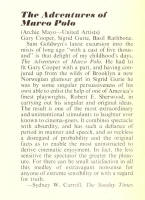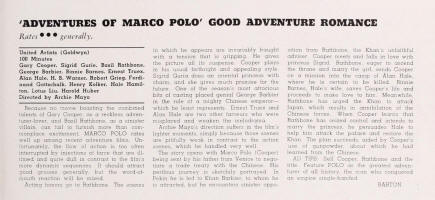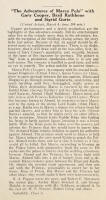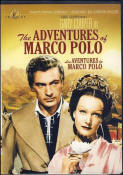The Adventures of Marco Polo
|
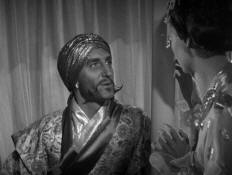 Ahmed informs the princess that she will marry him. |
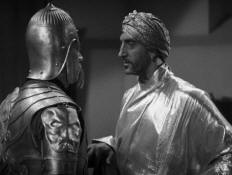 Ahmed receives disturbing news. |
Sigrid Gurie, a Norwegian, was a bizarre choice to play a Chinese princess in The Adventures of Marco Polo. Though ethnically miscast, she did well. She was exotic, delicate, and subtle.
Sigrid Gurie was presented to Hollywood as Samuel Goldwyn's discovery and hailed as "the siren of the fjords." There were few details available about heronly that she was a great Norwegian actress miraculously found and persuaded to lend her luster to the American screen. Goldwyn had kept her hidden for months, forbidding her to visit a night club or a popular luncheon spot or meet any picture people.
Shortly before the premiere of The Adventures of Marco Polo, Sigrid's true past was disclosed. She was Norwegian, true enough, but born in Brooklyn, New York. Her parents were Norwegian and the family moved back to Norway when Sigrid was three years old. She grew up in Oslo, Norway. Sigrid came to Hollywood in 1935, and tried to break into the movies. So she was not a star, after all, but a novice!
A Life magazine article reported, "Mr. Goldwyn's picture of a new Norwegian Garbo was badly jolted in March when Miss Gurie filed suit for divorce from a hitherto unsuspected husband. It speedily became known that not only was she married to an American luggage-maker, but that her birthplace, far from romantic Norway, was the Flatbush section of Brooklyn, NY. The stunned Mr. Goldwyn recovered in time to snatch victory from defeat by proclaiming 'the greatest hoax in movie history.'" ("Flower of Flatbush," Life, April 18, 1938)
But did Sam Goldwyn indeed perpetrate this hoax, or did Sigrid pretend to be a Norwegian star and fool Mr. Goldwyn?
The cost of producing The Adventures of Marco Polo was about $2,000,000. The budget for settings alone amounted to $600,000. Samuel Goldwyn built a replica of a two-hundred yard long section of the Great Wall in China. That replica cost $72,000.
One thousand extras were used for location shooting at Malibu Lake, causing a shortage of extras elsewhere and a hold-up on several Western pictures.
In order to forestall possible rumors of cruelty to animals, a committee from the SPCA was invited to witness battle-scene rushes involving 250 horses.
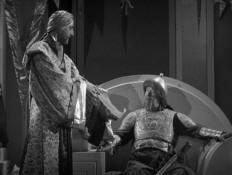 Ahmed orders Khan to sign a decree naming Ahmed as the rightful heir to the Khan. |
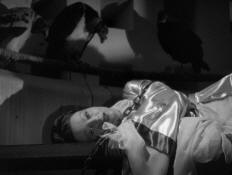 In order to force the Khan to his will, Ahmed has chained the princess near hungry vultures. |
The Adventures of Marco Polo was at first scheduled to be released during Christmas week, 1937. The release was pushed to January 1938, and then to February. Difficulties in affecting a nationwide, simultaneous boost in admissions was apparently the chief obstacle in setting a definite date for the release of the film.
The Adventures of Marco Polo was finally released in New York City on April 15, 1938. Twenty-three thousand people attended the premiere at the Radio City Music Hall. More than 140,000 people saw the movie during the first week of its presentation. On Broadway The Adventures of Marco Polo earned $92,000 the first week, and $100,000 the second week. During the third and final week at the Music Hall, the film earned $70,000.
Earnings for The Adventures of Marco Polo in other cities:
- Baltimore $12,000 the first week (April 20, 1938).
- Philadelphia $15,000 the first week, and $9,800 the second week (April 27, 1938).
- Chicago $4,000 (May 4, 1938)
- Detroit first week $6200, second week $4500 (May 11, 1938)
- Boston In a double bill with Gaiety Girls, $15,600 (May 18, 1938)
- San Francisco first week $10,000, second week $9300, third week $7500, fourth week $5500 (beginning May 18, 1938)
- Washington DC $13,000 (May 25, 1938)
The Adventures of Marco Polo had a strong start, with record breaking attendance figures in key cities throughout the country, and appeared to be a hit, but it fizzled fairly quickly. It ended up being a flop, and losing about $700,000.
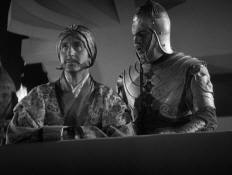 From his balcony Ahmed looks over the city. |
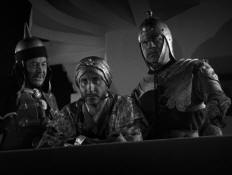 A guard brings news. |
In spite of having flopped at the box office, The Adventures of Marco Polo, won for its maker, Samuel Goldwyn, two gold medals. The first was awarded by the League of Nations Picture Committee in June 1938. The second was awarded by the International Committee for Motion Picture Arts and Letters in July 1938.
Comments from motion picture theatre owners in 1938:
"I must say that this is one of the best pictures that I have seen this year, filled with plenty of action, with romance closely woven so as to make it enjoyable for everyone." Alex Hilton, Pal Theatres, Inc., Vidalia, Georgia
"We thought this splendid entertainment but it flopped badly. We expected this would draw quite well but were very much disappointed. Cooper was in top form in this. Miss Gurie was liked by those who were here." L. A. Irwin, Palace Theatre, Penacook, New Hampshire
"This proved a box office disappointment to us. We really took it on the chin. A fair picture that did not draw." Harland Rankin, Plaza Theatre, Tilbury, Ontario, Canada
"A swell show and my customers raved about it. The only thing they didn't like is that it was too long." Ray S. Hanson, Fox Theatre, Fertile, Minnesota
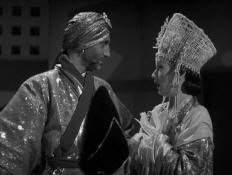 Ahmed tries to force the princess to marry him. |
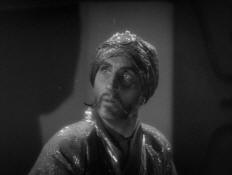 The wedding is interrupted by Marco Polo! |
"Personally, I thought this great. Comments from patrons were mixed. It don't seem to be a ladies' picture." K. A. Spears, Roxy Theatre, Winlock, Washington
"My guess is that this picture will not break any records in a small town. But make no error, it is great in all ways. Lavish in its settings, good story, care in direction and Miss Gurie has that something. You'll have to hand it to Goldwyn, he goes the whole way in finishing anything he starts. Not all of the patrons will go for this type of a picture, but when you have run it, you know that they have seen a picture, whether they like it or not. Sure it costs more money, but I would rather have less business than have to apologize for what I run. It has everything, comedy and drama." A. E. Hancock, Columbia Theatre, Columbia City, Indiana
"Send Bob Sherwood back to the magazine writing field if this is the best he can do for the movies. I remember how caustic he was in his comments upon the movies when he was critic upon the staff of a leading publication. Will someone step forth and give Bob a taste of the same kind of medicine he formerly gave out? 'Marco Polo' would make a good two reel subject. Gary Cooper wasted." Harry M. Palmer, Temple Court Theatre, Washington, Indiana
"Liked by all. Extended runs in any spot." W. E. McPhee, Strand Theatre, Old Town, Maine
"Personally, I thought very interesting, but my patronage stayed away from this one." Ouida Stephano, Grove Theatre, Groveton, Texas
"This is a fine picture, good in every detail and excellent entertainment. Miss Gurie made a very favorable impression. You can't go wrong on this one." Bill Simon, Rialto Theatre, Saguache, Colorado
"Good picture of its kind but most of the movie patrons do not care for this type of picture." P. G. Held, New Strand Theatre, Griswold, Iowa
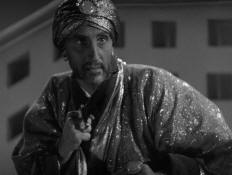 Ahmed attacks Marco Polo with a knife. |
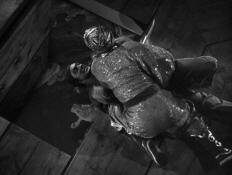 Ahmed and Marco wrestle near the trap door opening to the lion's den. Marco gets the upper hand and Ahmed falls to the lions. |
* * * * *
Back to Page One for reviews and pictures from the film. See Page Three for pictures of posters, lobby cards and promo photos.
.
|
The Adventures of Marco Polo is available on DVD
|







